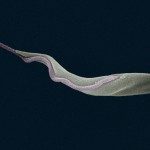Link to Pubmed [PMID] – 20846338
Cell. Microbiol. 2011 Jan;13(1):81-91
Laboratory mice display features of bona fide hosts for parasites such as Leishmania major and Leishmania donovani. Characterizing the amastigote population size fluctuations and the mouse transcript abundance accounting for these fluctuations demands the capacity to record in real time and integrate quantitative multiparametric datasets from the host tissues where these processes occur. To this end, two technologies, luciferase-expressing Leishmania imaging and a very sensitive quantitative analysis of both Leishmania and mouse transcripts, were combined. After the inoculation of either L. major or L. donovani, the amastigote population size fluctuations – increase, plateau and reduction – were monitored by bioluminescence. It allowed a limited number of mice to be selected for further analysis of both mouse and amastigote transcripts using the real-time quantitative polymerase chain reaction assay we set up. The illustrative examples displayed in the present analysis highlight a correlation between the transcriptional signatures displayed by mouse tissues with the amastigote burden fluctuations. We argue that these two combined technologies will have the potential to provide further insights on complex phenotypes driven by Leishmania developmental programs in the tissues of the mammal hosts.


